Reviewer's Note: The black LF2XT was provided for review by CPF dealer LED Cool. Please see his Dealer's thread in CPFM for more info.
Warning: Pic heavy!
Manufacturer's specifications, as taken from LED Cool's CPFMP thread:

The LF2XT is the newest member of the clicky-based LiteFlux family, bringing a revised version of their innovative circuit to the 1xAAA form factor. Building on their 1xCR123A/RCR model, the LF3XT, the LF2XT again features two separate user interfaces that you can switch between at will.
The Compact User interface (CUI) is very similar to the Nitecore D10/EX10, and the Full User Interface (FUI) allows full programmable control over the light (similar to Novatac or Ra lights). The CUI is a model of simplicity, and very easy to use right out of the box.
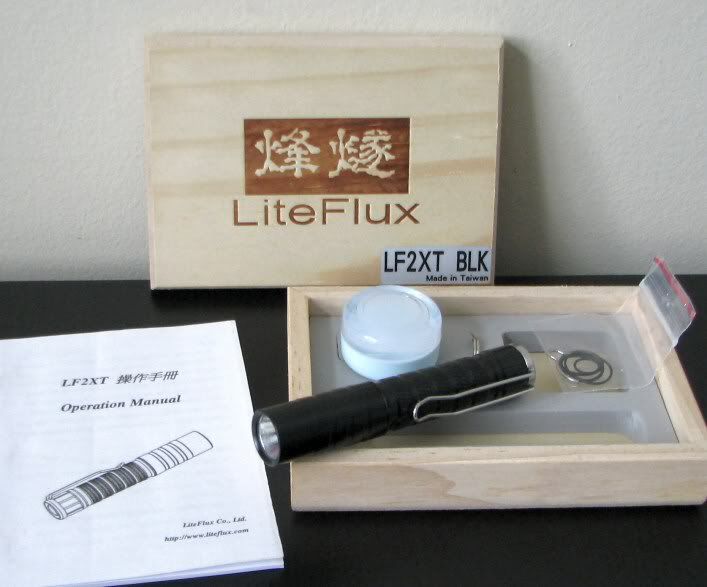
The LiteFlux packaging is similar among all models, and comes with a nice wooden presentation box. Light comes with a pocket clip installed, and package contains a manual, replacement keychain clip and split-ring, spare o-rings, and lube.
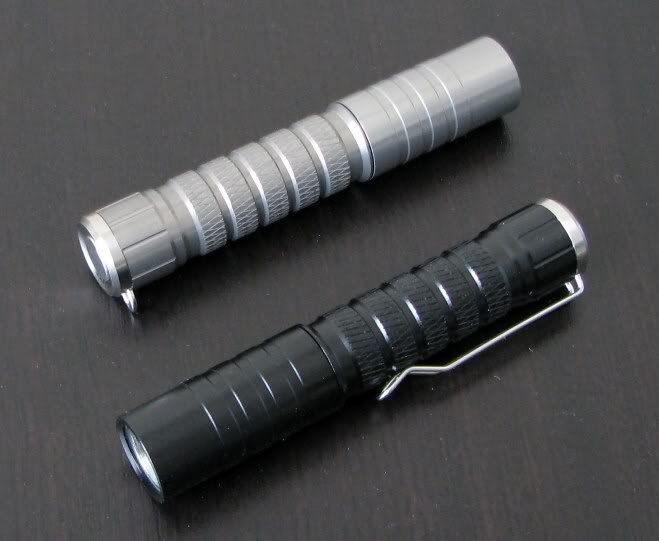

(from left to right: 1xAAA Duracell, LF2XT Natural, Lumapower Avenger GX, Fenix L0D, JetBeam Jet-µ, Nitecore EZAA, LF2XT Black)
Both the Natural finish and Black finish lights are shown above (I installed keychain clip in the Natural finish light). I personally like the medium-gray colour of the Natural finish, as it should make anodizing nicks and damage after prolonged keychain carry less noticeable. There is a slight mismatch in the natural finish between the head and body, but this is common on all natural finish lights (due to different batches of anodizing).
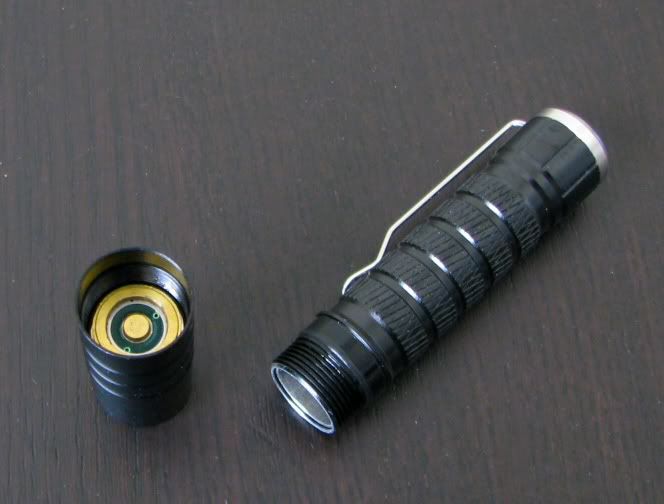
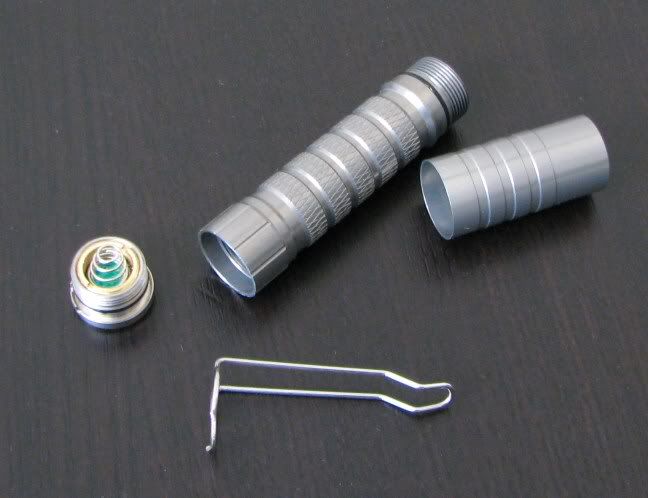
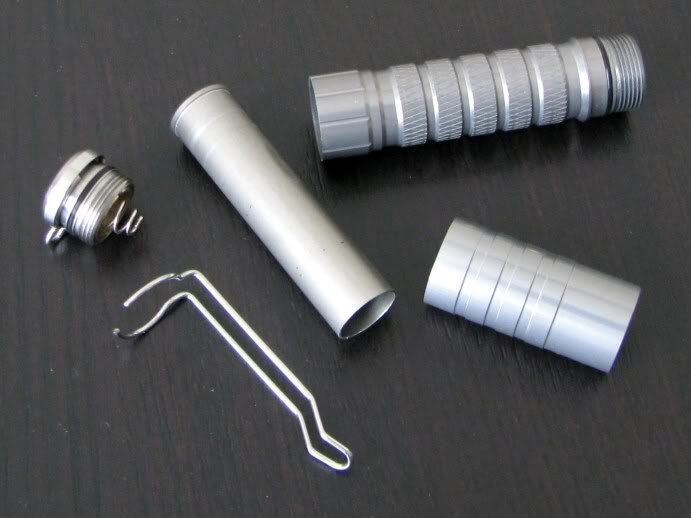

Despite the clicky switch and interior battery tube, size and weight remain fairly low.
Weight: 21.1g (Nat), 21.3g (black) with pocket clip installed (-0.5g if keychain ring clip installed)
Length x Width: 81.2mm x 14.9mm (bezel widest portion)
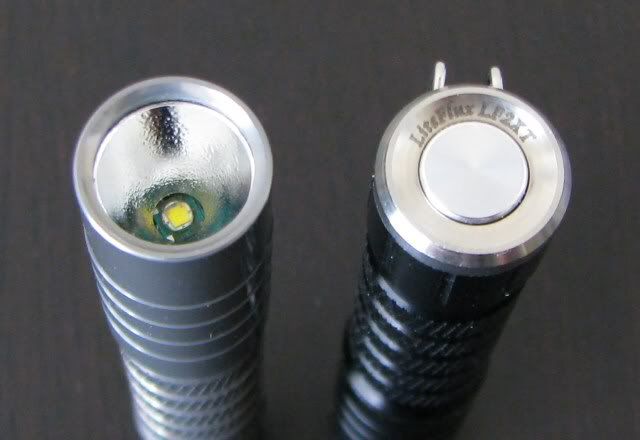
Clicky feel is similar to the other LiteFlux LFxXT series. Unlike a traditional clicky switch with a long traverse, these are more like the electronic switches that you will find on a number of modern devices (e.g. LCD monitors, DVD players, etc.). Only a light touch is required to activate the switch.
Fit and finish are excellent on my samples (sorry for the dusty and grainy pics above - it was an overcast day ). The minimal lettering on the stainless steel tailcap is very clear and sharp, and the type-III hard anodizing is flawless on both samples. I like the fact that labels are kept to a minimum.
). The minimal lettering on the stainless steel tailcap is very clear and sharp, and the type-III hard anodizing is flawless on both samples. I like the fact that labels are kept to a minimum. 
What little knurling that is present is pretty mild, but the concentric ridges and raised portions all along the length help considerably with grip. I find the installed pocket clip to be a bit on the thin side, but given the low weight of the light should work fine. Good that you can easily switch it for the keychain clip, which is my preferred carry for 1xAAA lights.
Screw threads are anodized for head lock-out, and the light can tailstand. :thumbsup:
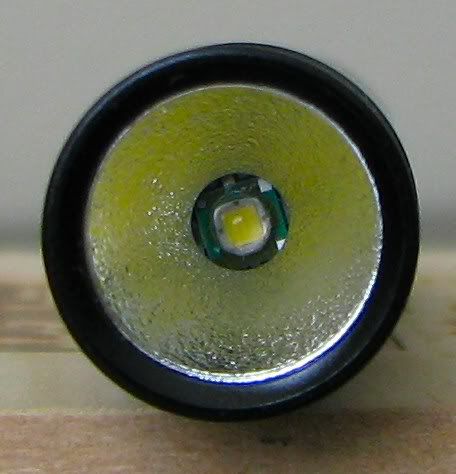
The light uses the new smaller Cree Q5 XP-E emitter, currently with a Q4 output bin and "neutral tint" bin of 4C. For those of you not familiar with tints, standard white LEDs are considered to be "cool tint", and what most people call warm tints are in fact "neutral" or "neutral-warm". For more information on tints and color perception, please see my Colour tint comparison and the summary LED tint charts found here.
My first impression when I turned on the LF2XT was "Wow, that's a nice tint." oo: I am not personally a fan of the common neutral-warm Cree tints such as 5A (I find them a bit too orange in actual use). In contrast, the 4C is a lot more yellow than orange, and closer to incandescent in my eyes. Note that a limited run on LF2XT with cool white R2 emitters is also in the works (WH tint, which is toward the warmer green/yellow range of cool white tints).
oo: I am not personally a fan of the common neutral-warm Cree tints such as 5A (I find them a bit too orange in actual use). In contrast, the 4C is a lot more yellow than orange, and closer to incandescent in my eyes. Note that a limited run on LF2XT with cool white R2 emitters is also in the works (WH tint, which is toward the warmer green/yellow range of cool white tints).
XP-E emitters with textured reflectors typically have fairly smooth beams with minimal Cree rings, and the LF2XT is no exception. The reflectors have at least a medium level of orange peel texturing.
Comparison Beamshots
All lights are on 100% on Sanyo Eneloop (NiMH), about 0.5 meters from a white wall.
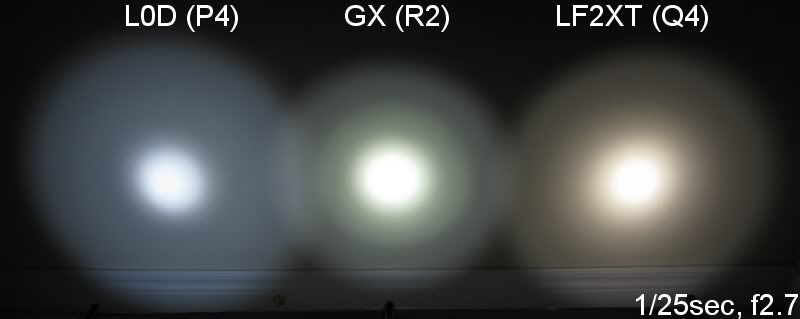
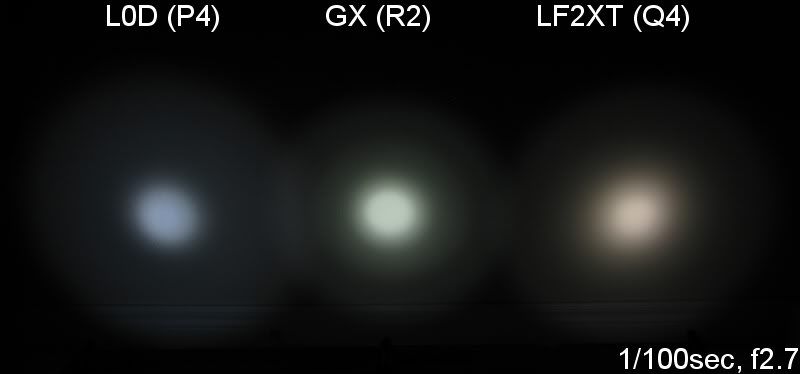
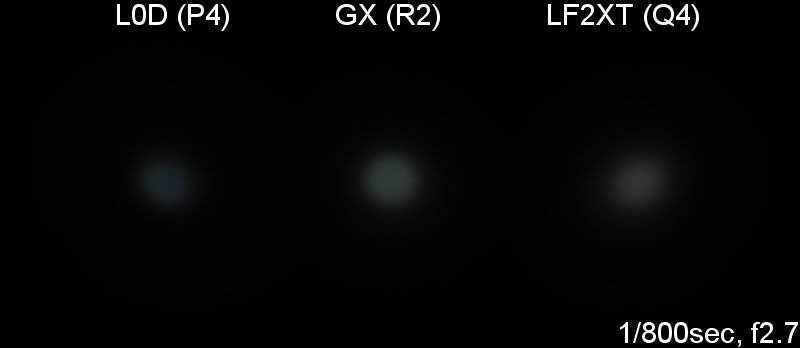
The camera is accentuating the tint difference a bit, but the Fenix L0D (older Cree P4 model) does indeed have a slight bluish Cool White tint. The Lumapower Avenger GX is on the warm end of Cool White (maybe a WG-WH tint). The LF2XT is not as orange as the pic above suggests – a lot more yellow (4C neutral tint).
The LF2XT beam is very smooth, with an even transition from hotspot to spill. :thumbsup:
User Interface
Like its big brother the LF3XT, the LF2XT is a remarkably versatile light with two user-selectable interfaces that should please KISS-fans as well those wanting a fully user-customizable light. :kiss:
In Compact User Interface (CUI), the light is remarkably similar to the Nitecore D10/EX10 - but with a few differences. With the head fully tightened, click for on/off. When on, press and hold to begin the ramp, release to select the desired level. Shortcuts to Min (double-click) and Max (click-press/hold) are included.
The main complaint with the D10/EX10 interface is that your custom-set level is erased when you use the shortcuts (i.e. jump to Min, and Min is now your new custom-set level). In contrast, the LF2XT/LF3XT retains the user-selected output even when shortcuts are used. The shortcuts are actually a toggle - e.g. double-click for Min, double-click again or turn off/on and you are back to your pre-selected user level. This is actually very useful for those that like to keep a user-defined level.
Note however that the LiteFlux is different in that it always retains the memory of the user-defined level, even if the light is turned off after a shortcut has been used. (i.e. it also reverts back to user-defined level when turned back on) See my post #23 for a greater discussion of how this differs in practice from the NiteCore lights.
You can also re-program your LF2XT/LF3XT to act as a momentary-on instead of click-on (like you can do on the EX10 by unscrewing the head slightly), but I find this less useful for keychain carry.
The Full-function User Interface (FUI) is much more complex, and similar to the older LF5XT. Again, although the light is easy to use in practice once programmed, I you will need to refer to the manual when you want to re-program any features. Please refer to LED Cool's dealer thread on CPFMP or the LF2XT discussion thread here on CPF for more info on how to use it (there's also a programming flowchart available, for those more visually-inclined).
Low Voltage Cut-off
One key feature that can be toggled on/off from either UI is the low voltage over-discharge protection system (4 clicks + press-and-hold from the On state toggles it on/off in either UI mode). This cut-off protection applies to all battery types on the LF2XT, so you will only want to have it on for Li-ion (10440) and NiMH (2.8V and 0.8V cut-off, respectively).
This is an incredibly useful feature, since protected Li-ion is not possible in the 1xAAA size (and over-draining Li-ion even once could destroy the cell, and risk serious damage if attempted to re-charge). It's also very useful on NiMH - although many don't realize it, allowing your NiMH cells to drain to zero and stay there for any length of time is also damaging for the cells. :tsk:
UPDATE July 6, 2009: I forgot to mention it, but the over-discharge protection (ODP) feature also has another characteristic - it gives you a few warning flashes before the battery cuts-out. On my Natural LF2XT (i.e. LF2XT #1 in the runtimes below), the light started flashing intermittently within a couple of minutes before cutting out. These flashes are fairly slow, but increase in frequency just before shut down. However, since they only start in the last couple of mins, they weren't picked up in any of the runtime traces (where output is sampled at 30 sec intervals). My Black LF2XT seems to start showing the flashing a minute or two earlier, so you may begin to see some dips on the runtime curves near the end of those runs.
Also, BabyDoc informs me that the optional 3-minute Auto-Off feature is incompatible with the ODP - due to circuit limitations, turning on the Auto-Off feature toggles the ODP off. The Auto-Off feature may be useful to you if you are worried about accidental activation - but I think locking out the head for EDC carry is a much better idea. If you do use the Auto-Off, keep in mind the lack of ODP.
Pulse-Width-Modulation (PWM)
Like all continuously-variable lights, the LF2XT uses PWM to create its lower output modes. As usual for LiteFlux, the PWM is at a sufficiently high frequency as to be undetectable by the naked eye. :thumbsup: I measured my LF2XT samples at a frequency of 1.92 kHz (i.e. 1920 cycles per second), at all output levels including Max.
LF2XT
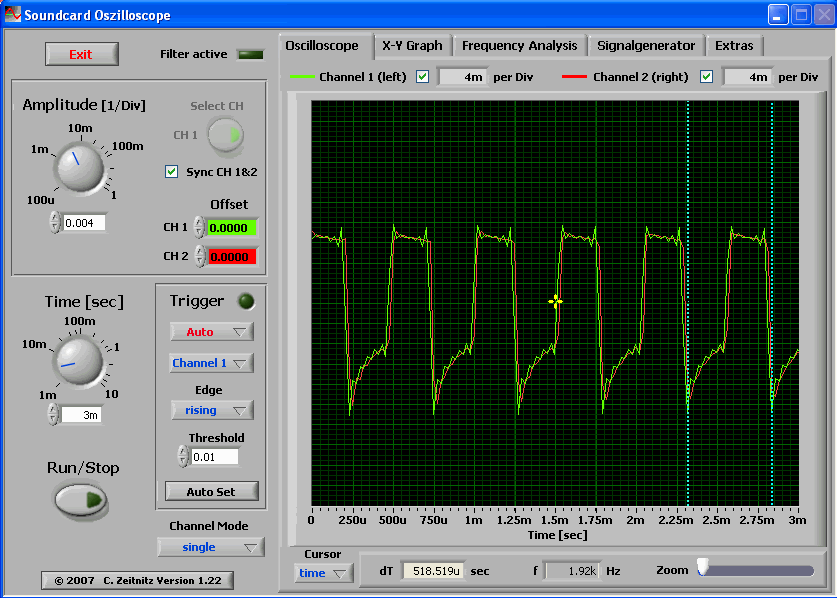
Basically, you will only be able to detect this level of PWM if you shine the light at a very rapidly moving fan (and even then, the effect is subtle). Note that this frequency is slower than the earlier LF3XT, which was around 7.8 kHz (sound card oscilloscope trace shown at the same scale below)
LF3XT
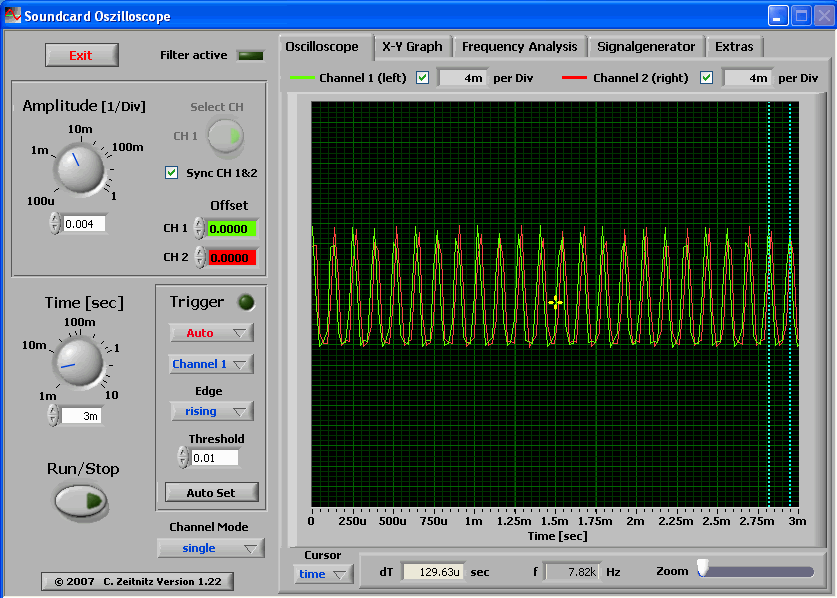
Either way, it is not a concern – you won't notice it on either light in practice (unlike <300 Hz PWM, which I typically find very :green
Response Lag
One last thing to note – due to how the MCU operates, there is a brief lag before a button press is registered and the light responds (except for turning on, which is instantaneous). As such, you can't rapidly double-click within 0.3 secs, or the light won't register the two separate actions (i.e. you have to allow 0.3 secs between each click). This takes some getting used to - but once you master taking it a bit slower, you should have no problems controlling the light.
Testing Method: All my output numbers are relative for my home-made light box setup, a la Quickbeam's flashlightreviews.com method. You can directly compare all my relative output values from different reviews - i.e. an output value of "10" in one graph is the same as "10" in another. All runtimes are done under a cooling fan, except for the extended run Lo/Min modes (i.e. >12 hours) which are done without cooling.
Throw values are the square-root of lux measurements taken at 1 meter from the lens, using a light meter.
Throw/Output Summary Chart:
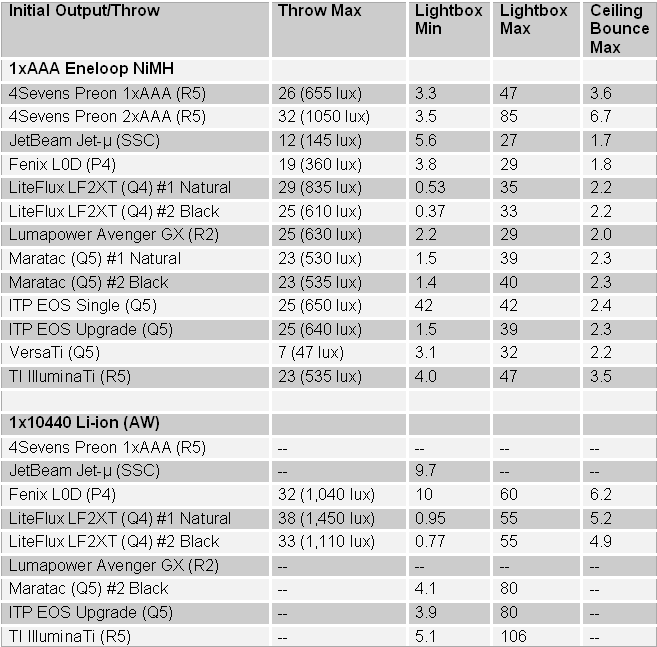
Note in the comparison above that my Fenix L0D is an early edition with a Cree P4. Based on a 350mA drive current (where Cree Output bins are determined), a Cree Q4 emitter would be expected to be ~25% brighter on average, and a Cree R2 would be ~40% brighter on average, for the same drive current. Note there is typically a ~7% output range over which an emitter is binned, so those numbers are just representational averages.
My two LF2XT samples are fairly close to each other in terms of Max output on most batteries, but are a little more variable in terms of throw (likely due to exact reflector placement during assembly). They are certainly well within the range I expected, and both have very good throw and output for this class of light – on all batteries.
Min output is remarkably low, although not quite as low as my LF3XT samples (which were 0.2-0.3 ROV for CR123A, and 0.4-0.5 for RCR). But the only other 1xAA or 1xCR123A lights that go as low as the LF3XT in my testing are the 4Sevens Quark and Novatac 120P (both ~0.2 ROV).
UPDATE April 13, 2015: In the years since this review came out, I have revised my testing protocol to provide more accurate ANSI FL-1 type measures. Specifically, I have devised a method for converting my lightbox relative output values (ROV) to estimated Lumens. See my How to convert Selfbuilt's Lightbox values to Lumens thread for more info.
I now also produce summary tables, reported in a manner consistent with the ANSI FL-1 standard for flashlight testing. Please see http://www.flashlightreviews.ca/FL1.htm for a discussion, and a description of all the terms used in these tables. Effective July 2012, I have updated all my Peak Intensity/Beam Distance measures with a NIST-certified Extech EA31 lightmeter (orange highlights).
Here is how the LF2XT (black version, on both NiMH AAA and 10440 Li-ion) from this review compares to more modern lights:
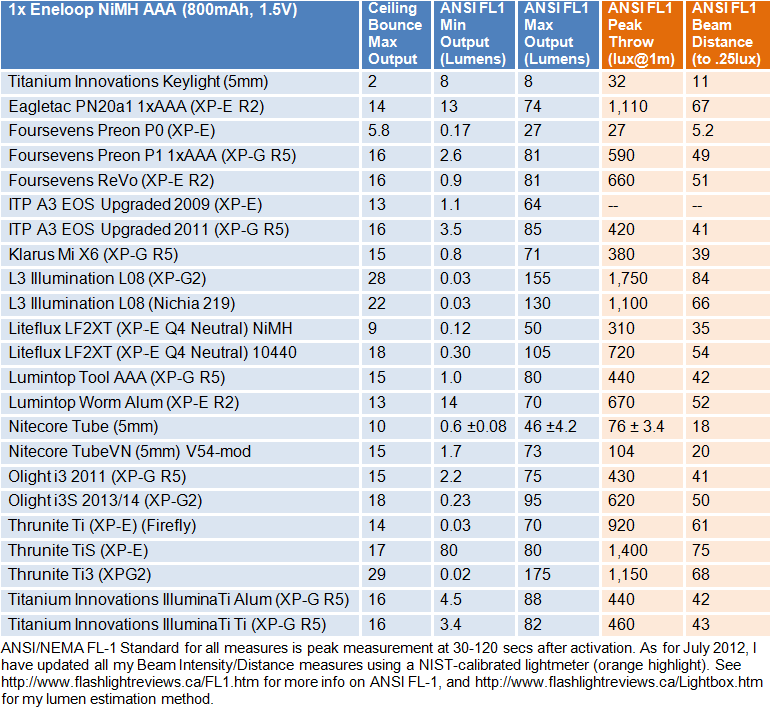
While max output is not as high, the LF2XT still remains quite competitive (especially on 10440). It also has among the lowest Min output I've seen in this class.
Variable Output Ramping

The CUI of the LF2XT uses a visually-linear ramp upon press-and-hold (shown above). It is in fact very similar in time scale to the LF3XT.
Output/Runtime Comparison:
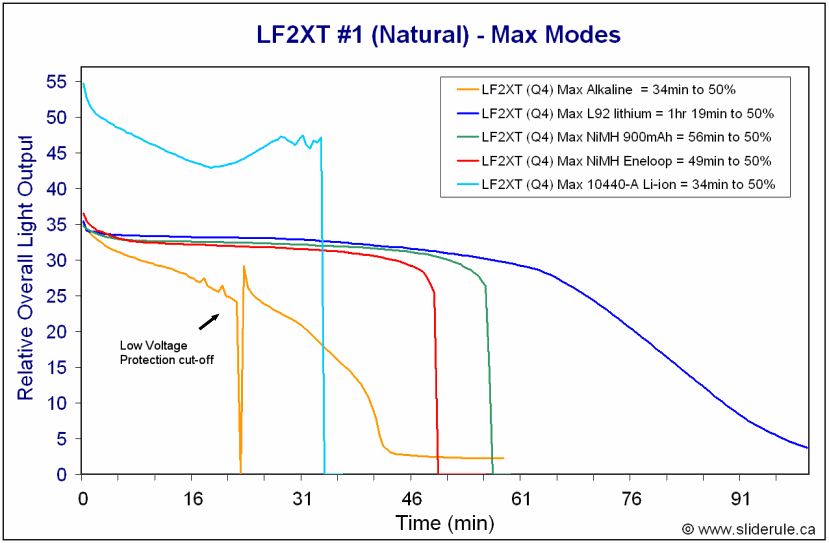
Note above that I inadvertently left the low-voltage protection feature turned on for the Max alkaline run. As you can see, this triggers a shut-down of the light while the battery still has a lot of charge remaining. I immediately restarted the light and toggled off the protection for the remainder of the run.
As you can see, this triggers a shut-down of the light while the battery still has a lot of charge remaining. I immediately restarted the light and toggled off the protection for the remainder of the run.
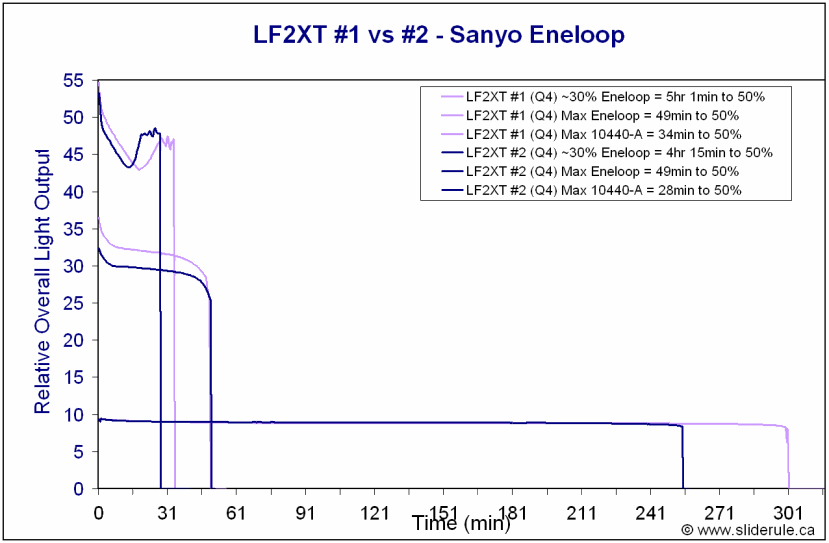
All the initial runtimes (shown below) were done on the Natural finish sample (labelled LF2XT #1). I have done a few additional runs on the Black finish sample (labelled LF2XT #2).
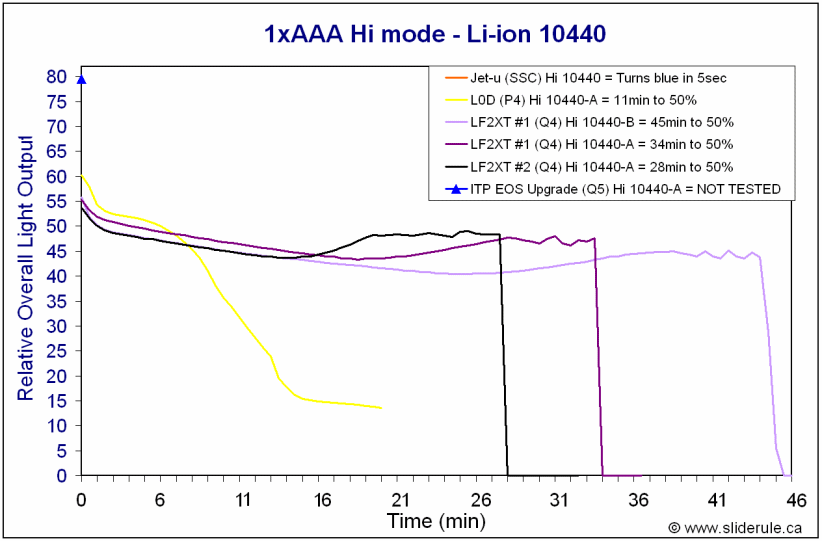
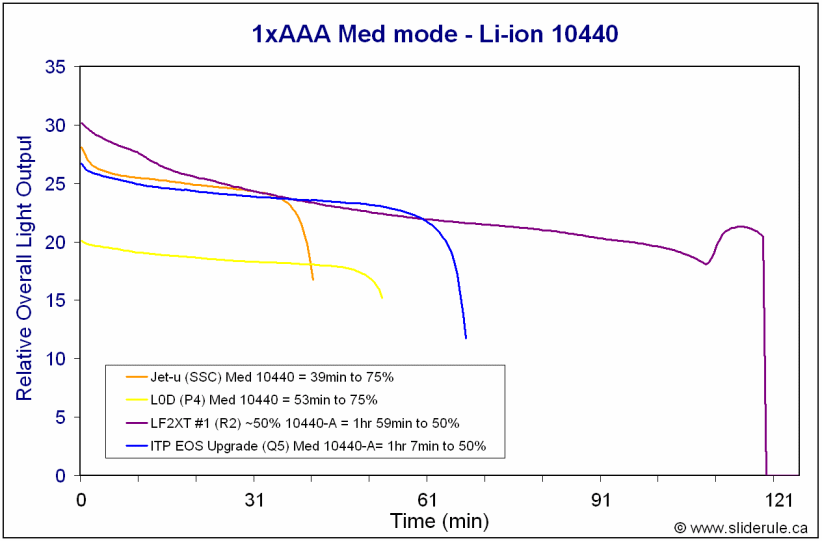
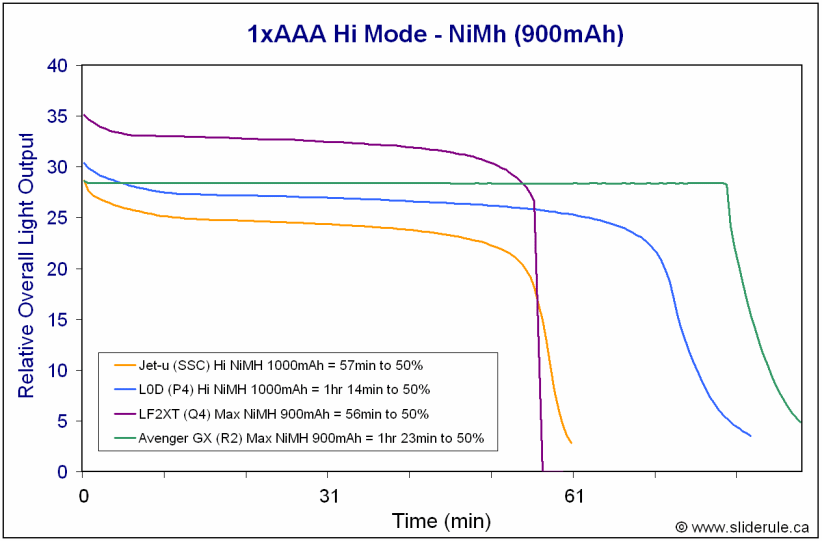
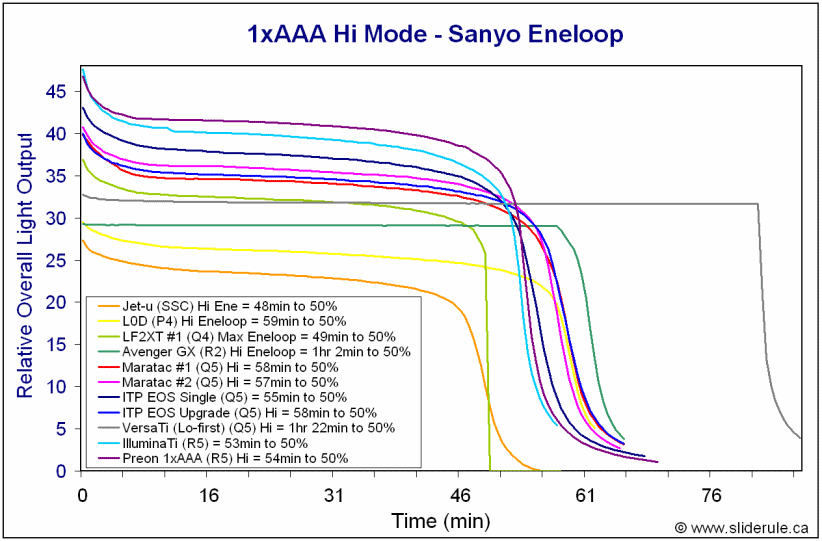
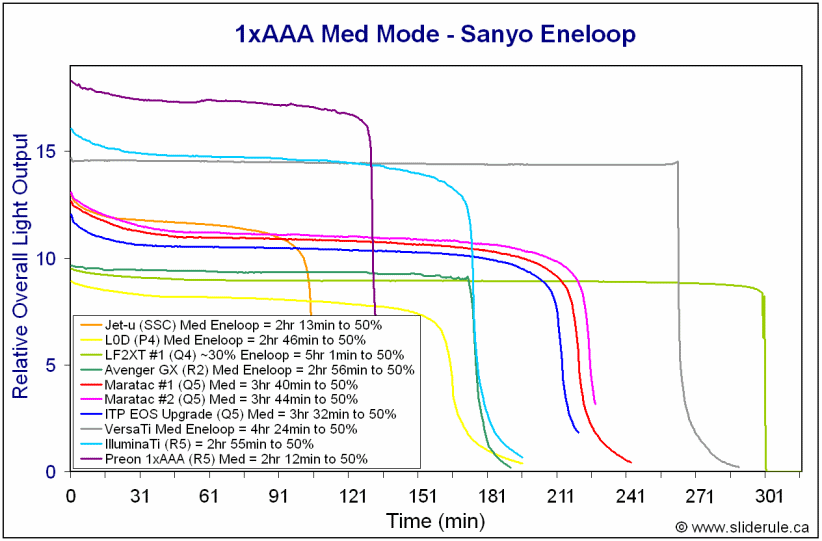
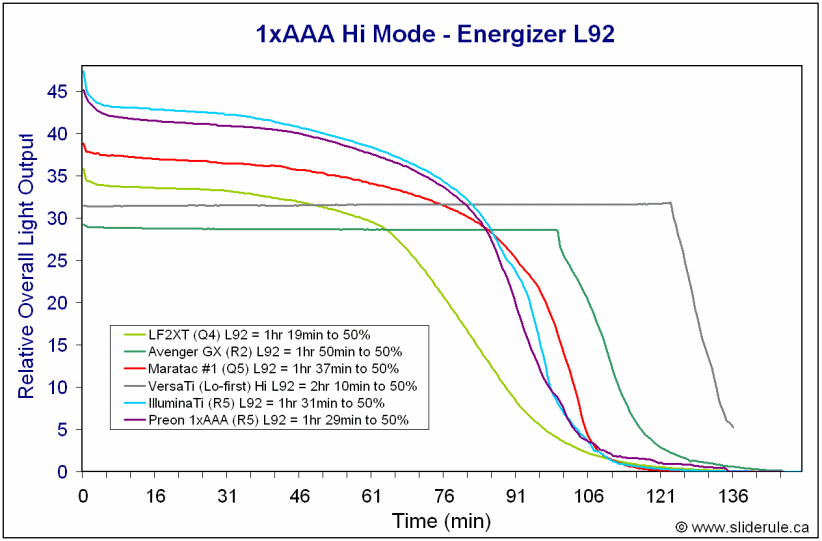
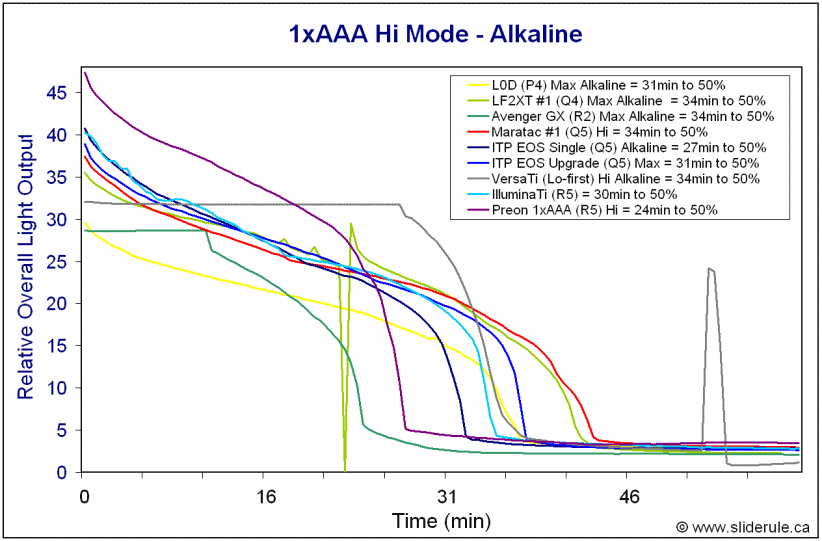
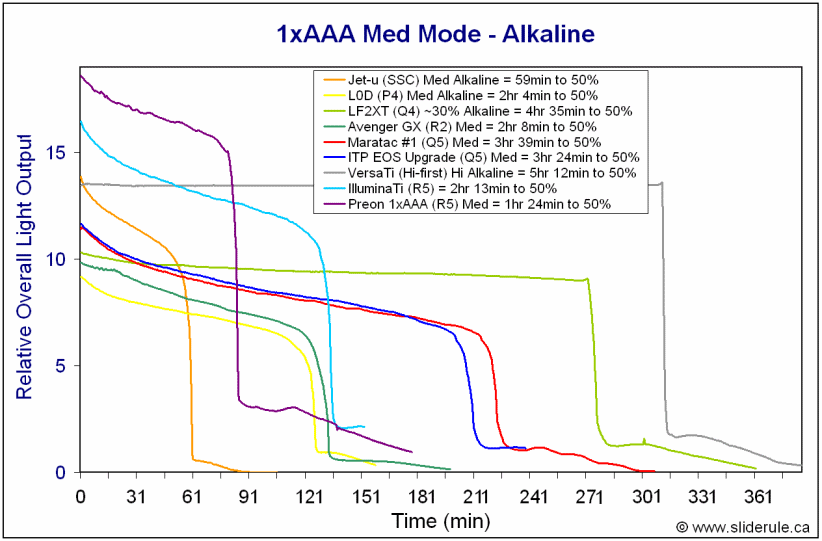
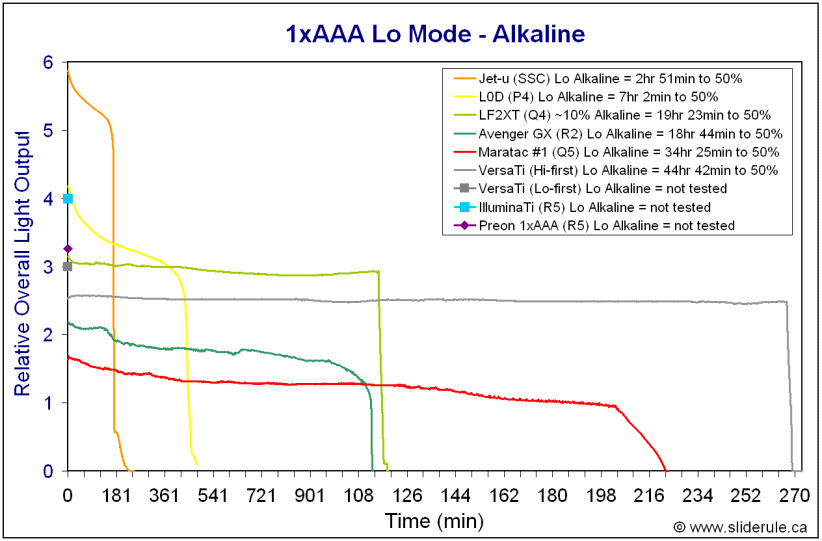
Output/Runtime Comments:
I don't have a lot of 1xAAA lights to compare to, and I would remind everyone again that my Fenix L0D is only a Cree P4 output bin (i.e. a Q4 would typically be ~25% brighter for the same drive current).
But I am VERY impressed with the output/runtime performance of the LF2XT on all batteries, at all levels. Performance is simply outstanding! :bow:
A lot of lights don't work too well on AAA alkaline batteries (due to their lower storage capacity and discharge limits), but the LF2XT is very impressive at all outputs. Of course, I don't recommend alkalines given their propensity to leak and potentially damage the light they are in.
Certainly no qualms about recommending any form of NiMH, including Sanyo Eneloops. A *really* nice feature is the low-voltage cut-off protection, which will prevent you from running down you NiMH cells and potentially damaging them. Good job – I wish more manufacturers would implement this! :thumbsup: Note that there is some variability in max output and runtime on the two samples I tested on Eneloops – this likely reflects Vf difference between the sample emitters.
And I am frankly stunned by how long my AW 10440 Li-ion batteries last in these lights oo: (again, protected thanks to the light's low voltage cut-off feature). There was a bit variability in output/runtime between two batches of 10440s in my collection (both purchased in 2007 and barely used), so YMMV. And you can see that my second LF2XT has shorter runtime than the first. But certainly a great way to pack a lot of storage density into a small form factor (and in a fully supported and protected way).
oo: (again, protected thanks to the light's low voltage cut-off feature). There was a bit variability in output/runtime between two batches of 10440s in my collection (both purchased in 2007 and barely used), so YMMV. And you can see that my second LF2XT has shorter runtime than the first. But certainly a great way to pack a lot of storage density into a small form factor (and in a fully supported and protected way).
Potential Issues
As mentioned previously, there is ~0.3 sec lag in responding to button presses (aside from turning On, which is instantaneous). Button also has a much shorter traverse and is softer feeling than a standard clicky - in keeping with being an electronic switch as opposed to a traditional switch. Not really problems per se, just a different set of expectations that may take some getting used to.
Although undocumented, BabyDoc confirms that enabling the auto-shut-off feature (i.e. shuts down after 3mins of runtime) automatically disables the low-voltage over-discharge protection (ODP) for NiMH/Li-ion. Apparently there are a limited number of memory positions for the light, and you can't have both features running simultaneously.
General Observations
I said it in my LF3XT review, and I'll say again here - I'm very impressed with this light so far. :twothumbs
I think LiteFlux suffers from a perception issue that their circuits are just too complicated to operate without a manual. This isn't the case at all – as set out of the box, the default compact interface is virtually identical to the popular NiteCore D10/EX10. If you can press a button, you can easily use this interface.
It's true the full user interface will require the use of the manual/flowchart to allow you set the features. But once set, the light is ridiculously simple to operate. Again, if you can turn on and switch modes in a Novatac or Ra light, you can use a programmed LF2XT/LF3XT. And the LiteFlux lights have a lot more features that you can program and customize than just about any other light. Set the Full UI the way you want with the manual, and then it's child's play to use without one.
Personally, I found the earlier twisty-model LiteFluxes to be a little finicky to operate and confusing to program. But the LF2XT/LF3XT series have two of the best user interfaces built-in, with a load of innovative features that are well worth price of admission (e.g. fully regulated Li-ion support, user-selectable low-voltage protection features for both Li-ion and NiMH, etc.).
Oh, and have I mentioned the outstanding runtime performance, on all batteries – including alkalines?
The beam is also very attractive with its neutral-warm 4C emitter (although relatively warm WH tints in cool white R2 should also be available by now). Despite the small reflector, the LF2XT's beam is very nice with minimal evidence of rings and a smooth transition from spot to spill. Overall spillbeam width is also a reasonable size.
Build quality is also high in my books. Light feels solid enough to finally replace the 1xAAA Jet-µ on my keychain. I'm going to EDC it for awhile and let you know how it goes. But based on my extensive EDCing of the LF3XT, I don't expect any major issues.
P.S.: While I generally don't like discussing value-for-money in my reviews (since I think that is a very personal thing), I have to say that these seem like a great deal for <$65 shipped.
Warning: Pic heavy!
Manufacturer's specifications, as taken from LED Cool's CPFMP thread:
- LED : CREE XP-E Q4 Neutral White tint (limited run R2 Cool White tint available soon)
- Input voltage : 0.9V - 4.50V (AAA/10440)
- AAA battery chemistry : Alkaline(1.5V), NIMH(1.2V), NICD(1.2), Primary Lithium(1.7V) & rechargeable Li-Ion 10440(4.2V)
- Uses PWM at high frequency. No flickering at min output.
- Removeable Orange peel aluminium reflector.
- Centered LED.
- Coated glass lens.
- Finish : HA III BLACK or NATURAL.
- Single o ring seal at lens, battery tube and tail cap.
- Stainless steel tail cap with laser engraving.
- Stable tail stand when stainless steel clip or keyring is installed.
- All parts can be dismantle for cleaning and maintenance.
- Water resistant for daily normal use. NOT suitable for diving or swimming.
- Size: Length 81mm, Diameter 14.55mm (bezel)
- Standard accessories: Wooden gift box, stainless steel clip, stainless steel keyring attachment, spare O rings, A small container of silicon lubricant for the o-rings, Chinese and English operation manual.
- 2-in-1 EDC light because it has 2 User Interfaces. Compact User Interface (CUI), which is the factory default UI, and Full-function User Interface (FUI).
CUI is those who prefer a simple straight forward UI, while FUI is for those who prefer to set up thier EDC light exactly the way they prefer. - Both UI provides battery over discharge protection. please refer to the user manual for more info.

The LF2XT is the newest member of the clicky-based LiteFlux family, bringing a revised version of their innovative circuit to the 1xAAA form factor. Building on their 1xCR123A/RCR model, the LF3XT, the LF2XT again features two separate user interfaces that you can switch between at will.
The Compact User interface (CUI) is very similar to the Nitecore D10/EX10, and the Full User Interface (FUI) allows full programmable control over the light (similar to Novatac or Ra lights). The CUI is a model of simplicity, and very easy to use right out of the box.

The LiteFlux packaging is similar among all models, and comes with a nice wooden presentation box. Light comes with a pocket clip installed, and package contains a manual, replacement keychain clip and split-ring, spare o-rings, and lube.


(from left to right: 1xAAA Duracell, LF2XT Natural, Lumapower Avenger GX, Fenix L0D, JetBeam Jet-µ, Nitecore EZAA, LF2XT Black)
Both the Natural finish and Black finish lights are shown above (I installed keychain clip in the Natural finish light). I personally like the medium-gray colour of the Natural finish, as it should make anodizing nicks and damage after prolonged keychain carry less noticeable. There is a slight mismatch in the natural finish between the head and body, but this is common on all natural finish lights (due to different batches of anodizing).




Despite the clicky switch and interior battery tube, size and weight remain fairly low.
Weight: 21.1g (Nat), 21.3g (black) with pocket clip installed (-0.5g if keychain ring clip installed)
Length x Width: 81.2mm x 14.9mm (bezel widest portion)

Clicky feel is similar to the other LiteFlux LFxXT series. Unlike a traditional clicky switch with a long traverse, these are more like the electronic switches that you will find on a number of modern devices (e.g. LCD monitors, DVD players, etc.). Only a light touch is required to activate the switch.
Fit and finish are excellent on my samples (sorry for the dusty and grainy pics above - it was an overcast day
What little knurling that is present is pretty mild, but the concentric ridges and raised portions all along the length help considerably with grip. I find the installed pocket clip to be a bit on the thin side, but given the low weight of the light should work fine. Good that you can easily switch it for the keychain clip, which is my preferred carry for 1xAAA lights.
Screw threads are anodized for head lock-out, and the light can tailstand. :thumbsup:

The light uses the new smaller Cree Q5 XP-E emitter, currently with a Q4 output bin and "neutral tint" bin of 4C. For those of you not familiar with tints, standard white LEDs are considered to be "cool tint", and what most people call warm tints are in fact "neutral" or "neutral-warm". For more information on tints and color perception, please see my Colour tint comparison and the summary LED tint charts found here.
My first impression when I turned on the LF2XT was "Wow, that's a nice tint."
XP-E emitters with textured reflectors typically have fairly smooth beams with minimal Cree rings, and the LF2XT is no exception. The reflectors have at least a medium level of orange peel texturing.
Comparison Beamshots
All lights are on 100% on Sanyo Eneloop (NiMH), about 0.5 meters from a white wall.



The camera is accentuating the tint difference a bit, but the Fenix L0D (older Cree P4 model) does indeed have a slight bluish Cool White tint. The Lumapower Avenger GX is on the warm end of Cool White (maybe a WG-WH tint). The LF2XT is not as orange as the pic above suggests – a lot more yellow (4C neutral tint).
The LF2XT beam is very smooth, with an even transition from hotspot to spill. :thumbsup:
User Interface
Like its big brother the LF3XT, the LF2XT is a remarkably versatile light with two user-selectable interfaces that should please KISS-fans as well those wanting a fully user-customizable light. :kiss:
In Compact User Interface (CUI), the light is remarkably similar to the Nitecore D10/EX10 - but with a few differences. With the head fully tightened, click for on/off. When on, press and hold to begin the ramp, release to select the desired level. Shortcuts to Min (double-click) and Max (click-press/hold) are included.
The main complaint with the D10/EX10 interface is that your custom-set level is erased when you use the shortcuts (i.e. jump to Min, and Min is now your new custom-set level). In contrast, the LF2XT/LF3XT retains the user-selected output even when shortcuts are used. The shortcuts are actually a toggle - e.g. double-click for Min, double-click again or turn off/on and you are back to your pre-selected user level. This is actually very useful for those that like to keep a user-defined level.
Note however that the LiteFlux is different in that it always retains the memory of the user-defined level, even if the light is turned off after a shortcut has been used. (i.e. it also reverts back to user-defined level when turned back on) See my post #23 for a greater discussion of how this differs in practice from the NiteCore lights.
You can also re-program your LF2XT/LF3XT to act as a momentary-on instead of click-on (like you can do on the EX10 by unscrewing the head slightly), but I find this less useful for keychain carry.
The Full-function User Interface (FUI) is much more complex, and similar to the older LF5XT. Again, although the light is easy to use in practice once programmed, I you will need to refer to the manual when you want to re-program any features. Please refer to LED Cool's dealer thread on CPFMP or the LF2XT discussion thread here on CPF for more info on how to use it (there's also a programming flowchart available, for those more visually-inclined).
Low Voltage Cut-off
One key feature that can be toggled on/off from either UI is the low voltage over-discharge protection system (4 clicks + press-and-hold from the On state toggles it on/off in either UI mode). This cut-off protection applies to all battery types on the LF2XT, so you will only want to have it on for Li-ion (10440) and NiMH (2.8V and 0.8V cut-off, respectively).
This is an incredibly useful feature, since protected Li-ion is not possible in the 1xAAA size (and over-draining Li-ion even once could destroy the cell, and risk serious damage if attempted to re-charge). It's also very useful on NiMH - although many don't realize it, allowing your NiMH cells to drain to zero and stay there for any length of time is also damaging for the cells. :tsk:
UPDATE July 6, 2009: I forgot to mention it, but the over-discharge protection (ODP) feature also has another characteristic - it gives you a few warning flashes before the battery cuts-out. On my Natural LF2XT (i.e. LF2XT #1 in the runtimes below), the light started flashing intermittently within a couple of minutes before cutting out. These flashes are fairly slow, but increase in frequency just before shut down. However, since they only start in the last couple of mins, they weren't picked up in any of the runtime traces (where output is sampled at 30 sec intervals). My Black LF2XT seems to start showing the flashing a minute or two earlier, so you may begin to see some dips on the runtime curves near the end of those runs.
Also, BabyDoc informs me that the optional 3-minute Auto-Off feature is incompatible with the ODP - due to circuit limitations, turning on the Auto-Off feature toggles the ODP off. The Auto-Off feature may be useful to you if you are worried about accidental activation - but I think locking out the head for EDC carry is a much better idea. If you do use the Auto-Off, keep in mind the lack of ODP.
Pulse-Width-Modulation (PWM)
Like all continuously-variable lights, the LF2XT uses PWM to create its lower output modes. As usual for LiteFlux, the PWM is at a sufficiently high frequency as to be undetectable by the naked eye. :thumbsup: I measured my LF2XT samples at a frequency of 1.92 kHz (i.e. 1920 cycles per second), at all output levels including Max.
LF2XT

Basically, you will only be able to detect this level of PWM if you shine the light at a very rapidly moving fan (and even then, the effect is subtle). Note that this frequency is slower than the earlier LF3XT, which was around 7.8 kHz (sound card oscilloscope trace shown at the same scale below)
LF3XT

Either way, it is not a concern – you won't notice it on either light in practice (unlike <300 Hz PWM, which I typically find very :green
Response Lag
One last thing to note – due to how the MCU operates, there is a brief lag before a button press is registered and the light responds (except for turning on, which is instantaneous). As such, you can't rapidly double-click within 0.3 secs, or the light won't register the two separate actions (i.e. you have to allow 0.3 secs between each click). This takes some getting used to - but once you master taking it a bit slower, you should have no problems controlling the light.
Testing Method: All my output numbers are relative for my home-made light box setup, a la Quickbeam's flashlightreviews.com method. You can directly compare all my relative output values from different reviews - i.e. an output value of "10" in one graph is the same as "10" in another. All runtimes are done under a cooling fan, except for the extended run Lo/Min modes (i.e. >12 hours) which are done without cooling.
Throw values are the square-root of lux measurements taken at 1 meter from the lens, using a light meter.
Throw/Output Summary Chart:

Note in the comparison above that my Fenix L0D is an early edition with a Cree P4. Based on a 350mA drive current (where Cree Output bins are determined), a Cree Q4 emitter would be expected to be ~25% brighter on average, and a Cree R2 would be ~40% brighter on average, for the same drive current. Note there is typically a ~7% output range over which an emitter is binned, so those numbers are just representational averages.
My two LF2XT samples are fairly close to each other in terms of Max output on most batteries, but are a little more variable in terms of throw (likely due to exact reflector placement during assembly). They are certainly well within the range I expected, and both have very good throw and output for this class of light – on all batteries.
Min output is remarkably low, although not quite as low as my LF3XT samples (which were 0.2-0.3 ROV for CR123A, and 0.4-0.5 for RCR). But the only other 1xAA or 1xCR123A lights that go as low as the LF3XT in my testing are the 4Sevens Quark and Novatac 120P (both ~0.2 ROV).
UPDATE April 13, 2015: In the years since this review came out, I have revised my testing protocol to provide more accurate ANSI FL-1 type measures. Specifically, I have devised a method for converting my lightbox relative output values (ROV) to estimated Lumens. See my How to convert Selfbuilt's Lightbox values to Lumens thread for more info.
I now also produce summary tables, reported in a manner consistent with the ANSI FL-1 standard for flashlight testing. Please see http://www.flashlightreviews.ca/FL1.htm for a discussion, and a description of all the terms used in these tables. Effective July 2012, I have updated all my Peak Intensity/Beam Distance measures with a NIST-certified Extech EA31 lightmeter (orange highlights).
Here is how the LF2XT (black version, on both NiMH AAA and 10440 Li-ion) from this review compares to more modern lights:

While max output is not as high, the LF2XT still remains quite competitive (especially on 10440). It also has among the lowest Min output I've seen in this class.
Variable Output Ramping

The CUI of the LF2XT uses a visually-linear ramp upon press-and-hold (shown above). It is in fact very similar in time scale to the LF3XT.
Output/Runtime Comparison:

Note above that I inadvertently left the low-voltage protection feature turned on for the Max alkaline run.
 As you can see, this triggers a shut-down of the light while the battery still has a lot of charge remaining. I immediately restarted the light and toggled off the protection for the remainder of the run.
As you can see, this triggers a shut-down of the light while the battery still has a lot of charge remaining. I immediately restarted the light and toggled off the protection for the remainder of the run.
All the initial runtimes (shown below) were done on the Natural finish sample (labelled LF2XT #1). I have done a few additional runs on the Black finish sample (labelled LF2XT #2).









Output/Runtime Comments:
I don't have a lot of 1xAAA lights to compare to, and I would remind everyone again that my Fenix L0D is only a Cree P4 output bin (i.e. a Q4 would typically be ~25% brighter for the same drive current).
But I am VERY impressed with the output/runtime performance of the LF2XT on all batteries, at all levels. Performance is simply outstanding! :bow:
A lot of lights don't work too well on AAA alkaline batteries (due to their lower storage capacity and discharge limits), but the LF2XT is very impressive at all outputs. Of course, I don't recommend alkalines given their propensity to leak and potentially damage the light they are in.
Certainly no qualms about recommending any form of NiMH, including Sanyo Eneloops. A *really* nice feature is the low-voltage cut-off protection, which will prevent you from running down you NiMH cells and potentially damaging them. Good job – I wish more manufacturers would implement this! :thumbsup: Note that there is some variability in max output and runtime on the two samples I tested on Eneloops – this likely reflects Vf difference between the sample emitters.
And I am frankly stunned by how long my AW 10440 Li-ion batteries last in these lights
Potential Issues
As mentioned previously, there is ~0.3 sec lag in responding to button presses (aside from turning On, which is instantaneous). Button also has a much shorter traverse and is softer feeling than a standard clicky - in keeping with being an electronic switch as opposed to a traditional switch. Not really problems per se, just a different set of expectations that may take some getting used to.
Although undocumented, BabyDoc confirms that enabling the auto-shut-off feature (i.e. shuts down after 3mins of runtime) automatically disables the low-voltage over-discharge protection (ODP) for NiMH/Li-ion. Apparently there are a limited number of memory positions for the light, and you can't have both features running simultaneously.
General Observations
I said it in my LF3XT review, and I'll say again here - I'm very impressed with this light so far. :twothumbs
I think LiteFlux suffers from a perception issue that their circuits are just too complicated to operate without a manual. This isn't the case at all – as set out of the box, the default compact interface is virtually identical to the popular NiteCore D10/EX10. If you can press a button, you can easily use this interface.
It's true the full user interface will require the use of the manual/flowchart to allow you set the features. But once set, the light is ridiculously simple to operate. Again, if you can turn on and switch modes in a Novatac or Ra light, you can use a programmed LF2XT/LF3XT. And the LiteFlux lights have a lot more features that you can program and customize than just about any other light. Set the Full UI the way you want with the manual, and then it's child's play to use without one.
Personally, I found the earlier twisty-model LiteFluxes to be a little finicky to operate and confusing to program. But the LF2XT/LF3XT series have two of the best user interfaces built-in, with a load of innovative features that are well worth price of admission (e.g. fully regulated Li-ion support, user-selectable low-voltage protection features for both Li-ion and NiMH, etc.).
Oh, and have I mentioned the outstanding runtime performance, on all batteries – including alkalines?
The beam is also very attractive with its neutral-warm 4C emitter (although relatively warm WH tints in cool white R2 should also be available by now). Despite the small reflector, the LF2XT's beam is very nice with minimal evidence of rings and a smooth transition from spot to spill. Overall spillbeam width is also a reasonable size.
Build quality is also high in my books. Light feels solid enough to finally replace the 1xAAA Jet-µ on my keychain. I'm going to EDC it for awhile and let you know how it goes. But based on my extensive EDCing of the LF3XT, I don't expect any major issues.
P.S.: While I generally don't like discussing value-for-money in my reviews (since I think that is a very personal thing), I have to say that these seem like a great deal for <$65 shipped.
Last edited:



